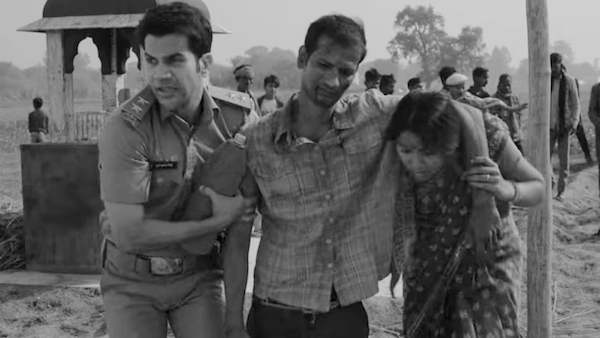Exodus in Black and White: ‘Bheed’ Depicts How Millions of Migrant Laborers Navigated the Pandemic and Prejudice
- The film by director Anubhav Sinha lays bare “insidious social discrimination to craft a compelling statement” about the inequities of caste and class.

Given its 1.4 million population, everything happens in India on a grand scale. That might fascinate or shock people in most countries that are comparatively small in numbers. But in a country that attracts tens of thousands of people on a dime, the plight of 10 million migrant laborers, displaced by Covid lockdowns, walking hundreds of miles to their home villages under the scorching sun, hardly raises eyebrows, let alone generates outrage. Even less so, as they belong to the so-called low castes.
It is, therefore, not surprising that the film “Bheed” which depicts the harrowing story of migrant laborers as they navigated their way back home after being unceremoniously ousted from their livelihoods and consequently from their shanty abodes, has not necessarily resonated with the moviegoers. The film, which opened last week, has had an unimpressive debut at the box office, according to news reports.
Directed by Anubhav Sinha, the film starring Rajkummar Rao, Bhumi Pednekar, Pankaj Kapur and Ashutosh Rana in lead roles, has grossed a paltry $2,42,000 over the weekend, according to a report in the Forbes.

But it is significant that the film was made at all — a risky proposition in the highly polarized environment that is India today. Some critics credited director Sinha, who is known for his progressive leanings, for resisting the temptation to make it into a Modi-bashing fare, even if the BJP government had monumentally mismanaged the pandemic response. Instead, the director lays bare the caste inequities and “ cries for social justice without romanticizing it,” as Anju Kumar writes in The Hindu.
The only political allusion, as Nandini Ramnath writes in Scroll, is the check post, where migrant laborers are held up from proceeding to their villages, at the future site of a township is called Lotus Oasis, “making the movie a brave (and rare) allegory about present-day India seen through a health crisis.” Lotus is the ruling party’s symbol.
“Director Anubhav Sinha has kneaded the infection of novel coronavirus with insidious social discrimination to craft a compelling statement that stands out in the crowd of films made during the pandemic,” Kumar adds.
Most critics agree the depiction of caste trauma among the principal characters in the black-and-white drama is instructive. A review in The Guardian explains how the director took the scalpel to the caste system through his main protagonist who is a police officer preventing the laborers from proceeding to their villages for fear of them spreading the virus: “The officer Surya (Rajkummar Rao), is himself from a lower-caste family, but he’s climbing the ladder; he is a competent, decent cop who refuses kickbacks or bribes (just what a modern police force needs). Still, his boss never lets him forget his place, and we see how Surya has internalized prejudice too.”
“The audience has to closely listen to the surnames of the characters as the film captures how caste informs the behavior of a person,” Kumar weighs in. But for this critic, even more insightful is the director’s ability to illustrate how caste oppression impacts the whole persona of the film’s protagonist. “One of the most stirring strands of the film,” he writes “is how the specter of caste has scarred the soul of Surya, so much so that it has affected his performance in his love life. In love with an upper caste girl, Renu Sharma (Bhumi Pednekar), who is strangely unaware of what the relationship entails, Surya could not shake off his caste identity when he takes off his shirt. That he carries two stars on the shoulders of his uniform doesn’t empower him enough to open up a closed mall for the migrants or stand up to Balram when he threatens to take the law into his hands. He may be a part of the System but for Surya, justice is still in the hands of the socially powerful.”
Beyond the caste factor, however, one critic felt that the film has not gone far enough as an exposé. Ramnath says that “Bheed” suffers “from its hesitancy to follow through on its convictions. Despite plenty of hand-wringing about the problems that plague India, from petty-mindedness to self-interest, the film blames character motivations on the pandemic, rather than on innate biases that peep out from behind masks.”
She also feels the film has the “massive disadvantage of competing with amateur videos shot of the lockdown’s more-horrific moments … A host of web series and films have revisited this sorry chapter of recent history, including Madhur Bhandarkar’s “India Lockdown.” Vinod Kapri’s documentary “1232 Kms,” which followed a group of migrants who cycled back to their villages, is a more focused and far more effective portrayal of how impoverished Indians were left to their own devices during the first lockdown from 2020.”
Nevertheless, the cast of the film, too, received widespread praise. In the Hindustan Times review, Monika Rawal Kukreja says, “Story aside, some really nuanced performances additionally make Bheed a great watch. I won’t be exaggerating if I term this as one of the finest ensemble castings in recent times. Rao and Pednekar are in top form with their dialect, body language, confidence and the way they emote on screen. Their strength and vulnerability both touch you.”


